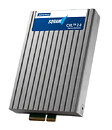- Joined
- May 21, 2024
- Messages
- 1,140 (3.51/day)
Advantech, a global leader in embedded computing, is excited to announce the release of the SQRAM CXL 2.0 Type 3 Memory Module. Compute Express Link (CXL) 2.0 is the next evolution in memory technology, providing memory expansion with a high-speed, low-latency interconnect designed to meet the demands of large AI Training and HPC clusters. CXL 2.0 builds on the foundation of the original CXL specification, introducing advanced features such as memory sharing, and expansion, enabling more efficient utilization of resources across heterogeneous computing environments.
Memory Expansion via E3.S 2T Form Factor
Traditional memory architectures are often limited by fixed allocations, which can result in underutilized resources and bottlenecks in data-intensive workloads. With the E3.S form factor, based on the EDSFF standard, the CXL 2.0 Memory Module overcomes these limitations, allowing for dynamic resource management. This not only improves performance but reduces costs by maximizing existing resources.



High-Speed Interconnect via PCIe 5.0 Interface
CXL memory module operate over the PCIe 5.0 interface. This high-speed connection ensures that even as memory is expanded across different systems, data transfer remains rapid and efficient. The PCIe 5.0 interface provides up to 32 GT/s per lane, allowing the CXL memory module to deliver the bandwidth necessary for data-intensive applications. Adding more capacity will have better performance and increased memory bandwidth without the need for more servers, and capital expenses.
Memory Pooling
CXL 2.0 enables multiple host to access a shared memory pool, optimizing resource allocation and improving overall system efficiency. Through CXL's memory pooling technology, computing components such as CPUs and accelerators of multiple servers on the same shelf can share memory resources, reducing resource redundancy and solving the problem of low memory utilization.
Hot-Plug and Scalability
CXL memory module can be added or removed from the system without shutting down the server, allowing for on-the-fly memory expansion. For data centers, this translates into the ability to scale memory resources as needed, ensuring optimal performance without disruption.
Key Features
View at TechPowerUp Main Site | Source
Memory Expansion via E3.S 2T Form Factor
Traditional memory architectures are often limited by fixed allocations, which can result in underutilized resources and bottlenecks in data-intensive workloads. With the E3.S form factor, based on the EDSFF standard, the CXL 2.0 Memory Module overcomes these limitations, allowing for dynamic resource management. This not only improves performance but reduces costs by maximizing existing resources.



High-Speed Interconnect via PCIe 5.0 Interface
CXL memory module operate over the PCIe 5.0 interface. This high-speed connection ensures that even as memory is expanded across different systems, data transfer remains rapid and efficient. The PCIe 5.0 interface provides up to 32 GT/s per lane, allowing the CXL memory module to deliver the bandwidth necessary for data-intensive applications. Adding more capacity will have better performance and increased memory bandwidth without the need for more servers, and capital expenses.
Memory Pooling
CXL 2.0 enables multiple host to access a shared memory pool, optimizing resource allocation and improving overall system efficiency. Through CXL's memory pooling technology, computing components such as CPUs and accelerators of multiple servers on the same shelf can share memory resources, reducing resource redundancy and solving the problem of low memory utilization.
Hot-Plug and Scalability
CXL memory module can be added or removed from the system without shutting down the server, allowing for on-the-fly memory expansion. For data centers, this translates into the ability to scale memory resources as needed, ensuring optimal performance without disruption.
Key Features
- EDSFF E3.S 2T form-factor
- CXL 2.0 is compatible with PCIe-Gen5 speeds running at 32 GT/s
- Supports ECC error detection and correction
- PCB: 30μ'' gold finger
- Operating Environment: 0 ~70°C (Tc)
- Compliant with CXL 1.1 & CXL 2.0
View at TechPowerUp Main Site | Source



